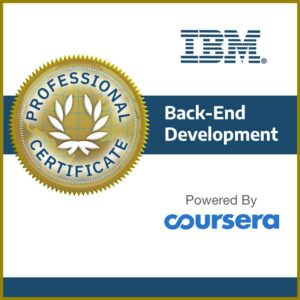The Coursera Professional Certificate “IBM Back-End Development” offers a comprehensive online program for aspiring back-end developers. It covers essential topics such as cloud computing, web development, Git, React, Node.js, Python, microservices, and containers. With hands-on projects and labs, learners gain practical experience and valuable skills. The program is suitable for both beginners and those with programming experience, making it a valuable investment for anyone pursuing a career in back-end development.
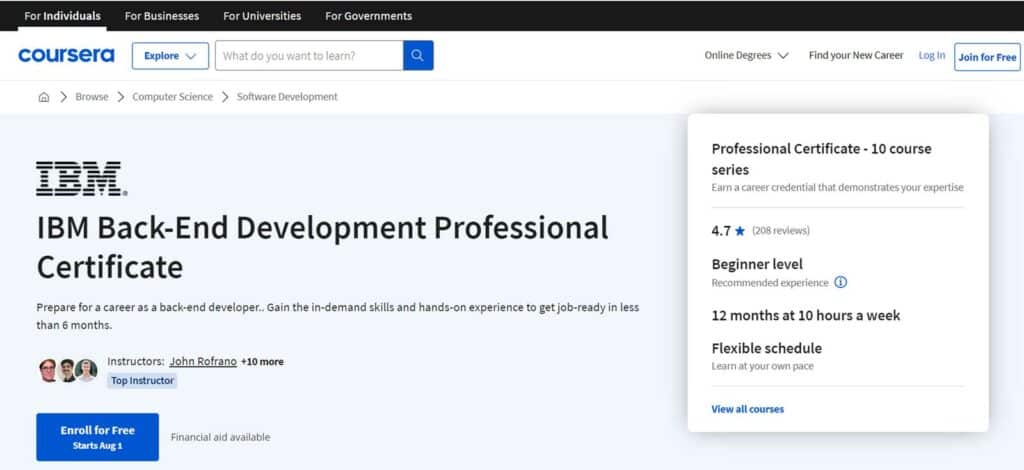
Table of Contents
Overview of the IBM Back-End Development Professional Certificate
The IBM Back-End Development Professional Certificate on Coursera is a well-crafted program for those eager to explore back-end development. Developed by IBM, a powerhouse in the tech industry, it offers a thorough curriculum, hands-on exercises, and real-world projects, all of which contribute to a solid foundation in the field.
What stands out about this program is its flexibility. While the full course requires a subscription, Coursera allows learners to audit the courses in the program for free, providing access to course materials without the certificate. This feature makes it an excellent choice for those dipping their toes into back-end development, a critical component of web and application development.
Compared to other courses on back-end development, this certificate stands out due to its association with IBM. It offers a level of industry relevance and comprehensive coverage of the subject matter that other courses may lack. However, for learners seeking to focus on specific topics, individual courses on Coursera or other platforms can be explored. The course’s affiliation with IBM adds a layer of credibility and relevance, making it an attractive choice for learners. IBM’s other professional certificates on Coursera, including the IBM Front-End Developer and IBM Full Stack Software Developer certificates, also offer valuable learning opportunities.
In my opinion, this course is a worthwhile investment for anyone looking to build a strong foundation in back-end development. It provides a comprehensive learning experience with a balance of theoretical knowledge and practical skills, making it a standout choice in the realm of online learning.
How much does the Professional Certificate cost? And is it worth it?
The IBM Back-End Development Professional Certificate, available on Coursera, is reasonably priced, considering the depth and breadth of the content. The program operates on a monthly subscription model, costing $49 per month. Given that the course is designed to be completed in about twelve months at a self-paced rate, the total expenditure would be approximately $588 if you stick to the suggested timeline.
It’s worth noting that this particular Professional Certificate isn’t part of the Coursera Plus subscription and, therefore, requires a separate purchase. However, if you’re mindful of your budget, you can aim to finish the program in less than the recommended twelve months, which could potentially lower the overall cost.
Additionally, Coursera allows you to audit the individual courses within this Professional Certificate at no cost. This option provides an opportunity to delve into the course content before making a financial commitment.
In summary, the IBM Back-end Development Professional Certificate offers a comprehensive learning journey and represents a sound investment for those looking to bolster their back-end development expertise.
Overall impression
The IBM Back-End Development Professional Certificate, accessible even to beginners, offers a broad spectrum of topics. It covers everything from software engineering to Python programming and cloud computing, providing a well-rounded understanding of back-end development. While it’s beginner-friendly, having a basic grasp of computer programming and web development can enhance the learning experience. The course is delivered by seasoned IBM professionals, whose expertise and industry knowledge are evident in the content. They manage to simplify complex topics, making them digestible for learners at all levels. I appreciate the course’s comprehensive approach and the clarity of instruction, which make it a valuable resource for anyone venturing into back-end development.
Detailed review
Syllabus overview
The “IBM Back-End Development” Professional Certificate is a robust 10-course program aimed at transforming beginners into job-ready back-end developers. It covers a wide array of tools and technologies, including Linux scripting, Python, SQL, Django, Docker, and more. What sets this program apart is its emphasis on practical application. Learners get to work hands-on, building server-side systems and services, which is a crucial aspect of modern web and mobile applications. The program also includes several projects that allow learners to apply their skills in real-world scenarios. Upon completion, learners receive a Professional Certificate from IBM and a portfolio of projects, which can be a significant confidence booster for job interviews. They also gain access to IBM’s Talent Network, a platform that provides job opportunities and personalized recommendations.
The ten component courses are:
- Introduction to Software Engineering
- Hand-on Introduction to Linux Commands and Shell Scripting
- Getting Started with Git And GitHub
- Python for Data Science, AI & Development
- Developing AI Applications with Python and Flask
- Developing Applications with SQL, Databases, and Django
- Introduction to Containers w/ Docker, Kubernetes & OpenShift
- Application Development using Microservices and Serverless
- Application Security and Monitoring
- Back-end Application Development Capstone Project
To give you a better idea of the program, we’ll go through each of these courses in more detail below.
Course 1: Introduction to Software Engineering
The IBM Back-End Development Professional Certificate on Coursera starts with the course “Introduction to Software Engineering,” which is an insightful journey into the world of software development. It is designed to cater to a wide audience, from beginners with no prior knowledge to professionals in related fields, making it an inclusive learning experience.
The course’s strength lies in its focus on the Software Development Lifecycle (SDLC) and Agile methodologies, which are crucial aspects of modern software development. The course does a commendable job of breaking down these complex topics into digestible modules, making it easier for learners to grasp these concepts. The use of real-world examples and case studies further enhances the learning experience, providing practical context to theoretical knowledge.
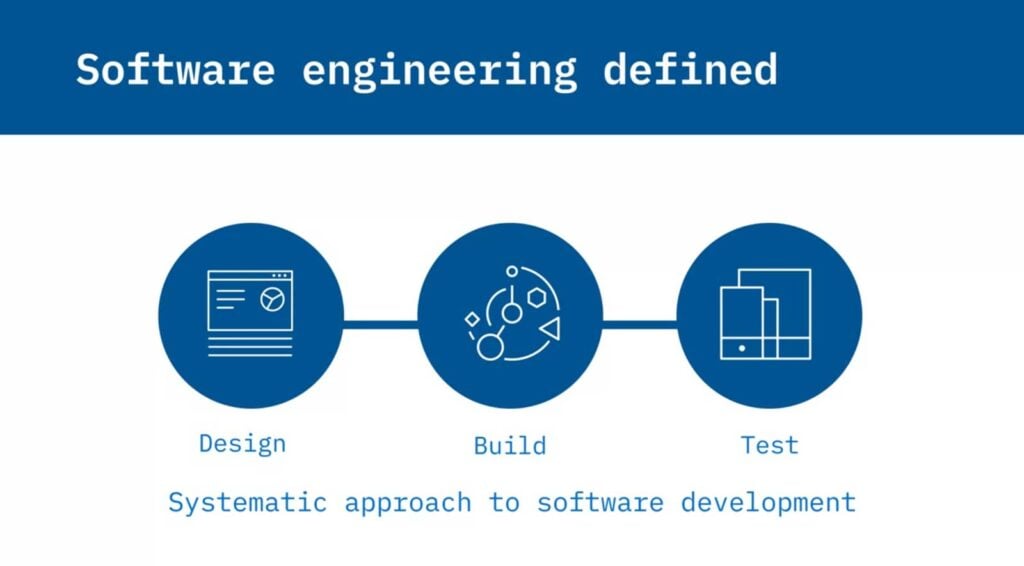
It also provides a basic introduction to programming using Python, which I found to be a good starting point for beginners, but it could have explained more concepts for aspiring software engineers. One aspect of the course that stood out to me was the inclusion of perspectives from both expert and novice software engineers. This provides a balanced view of the field and gives learners a realistic expectation of what a career in software engineering entails.
Overall, while the course provides a solid foundation in software engineering principles, it could benefit from a more in-depth exploration of practical programming skills. Nevertheless, it is a valuable resource for anyone looking to understand the field of software engineering and the career opportunities it offers.
Course 2: Hands-on Introduction to Linux Commands and Shell Scripting
The course for Linux Commands and Shell Scripting is a noteworthy component that does not just skim the surface but delves deep into the practical aspects of Linux, a cornerstone for any back-end developer. It is a robust course that offers a good balance of theory and practice, making it a valuable addition to the program.
The course is structured around four modules, each one designed to incrementally build your understanding of Linux and its command-line interface. The content is comprehensive, covering a wide range of commands from informational to networking and even text processing. This breadth of knowledge is invaluable, especially for those who aim to work in diverse server environments.
What sets this course apart is its emphasis on hands-on learning. The inclusion of labs to practice and apply the concepts learned is a commendable feature. Access to a virtual Linux server, which requires no downloads or installations, is a thoughtful addition that enhances the practical learning experience. It also introduces Bash shell scripting, a powerful tool for automating tasks. From simple scripts to more advanced ones involving variables, I/O redirection, and pipes & filters, the course provides a solid foundation for anyone looking to streamline their work using automation.
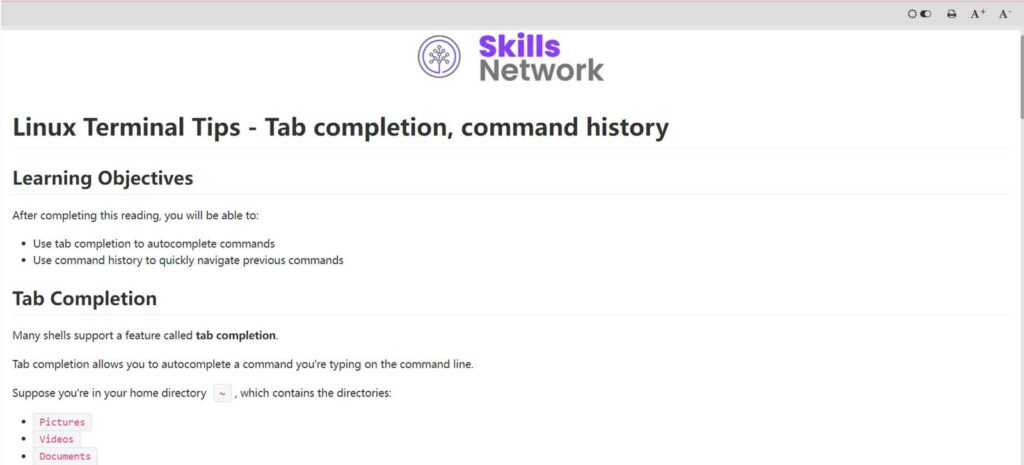
However, while the course is comprehensive and practical, it might feel a bit overwhelming for absolute beginners. The pace and depth of the course seem more suited for those with some prior exposure to Linux or similar operating systems.
Course 3: Getting Started with Git and GitHub
This course is designed to introduce learners to the world of Git and GitHub, two essential tools in the realm of web development. This three-week course is structured in a way that gradually builds your understanding of Git, a distributed version control system that is a cornerstone for managing both small and large software projects. It does a commendable job of breaking down complex concepts into digestible parts, making it easier for beginners to grasp the essentials of Git commands, repositories, branching, merging, and cloning workflows.
One of the highlights of this course is its focus on practical application. It is not just about learning the theory; it is about getting your hands dirty with real-world tasks. You will be guided through the process of creating a GitHub account, managing repositories, adding files, and committing changes. You’ll also get to explore branches, a key feature of Git-based version control systems, and learn how to collaborate effectively with other developers.
The course also provides ample opportunities to practice Git commands for cloning and forking repositories, as well as committing, pushing, and pulling changes using the command line. The final project is a nice touch, allowing learners to apply their newfound skills by creating a GitHub Project, sharing files like an open-source license, and showcasing their abilities.
Course 4: Python for Data Science, AI & Development
This is a beginner-friendly course that aims to equip learners with Python programming skills. From my perspective, it is a comprehensive course that does a commendable job of introducing Python and its applications in various domains. It is structured into five modules, each focusing on a different aspect of Python. The initial modules lay a strong foundation by covering Python basics and data structures. This is followed by a deep dive into Python programming fundamentals, which I believe are crucial for anyone looking to build robust applications.
One aspect of the course that stands out is its emphasis on practical learning. The course encourages learners to work with data in Python, read and write files, and use popular Python libraries like Pandas and Numpy. The final module, which introduces APIs and web scraping techniques, is a valuable addition that broadens the learner’s data collection capabilities. The hands-on labs using Jupyter Notebooks are a highlight of this course. They provide a real-world context for using Python and reinforce the concepts learned. However, I would have appreciated a bit more variety in the lab exercises to cater to different learning styles.
Overall, this course is an excellent starting point for beginners venturing into Python programming. It is comprehensive, practical, and accessible, even for those with no prior programming experience. However, the course is part of a larger program, and it’s essential to consider how it fits into your overall learning journey.
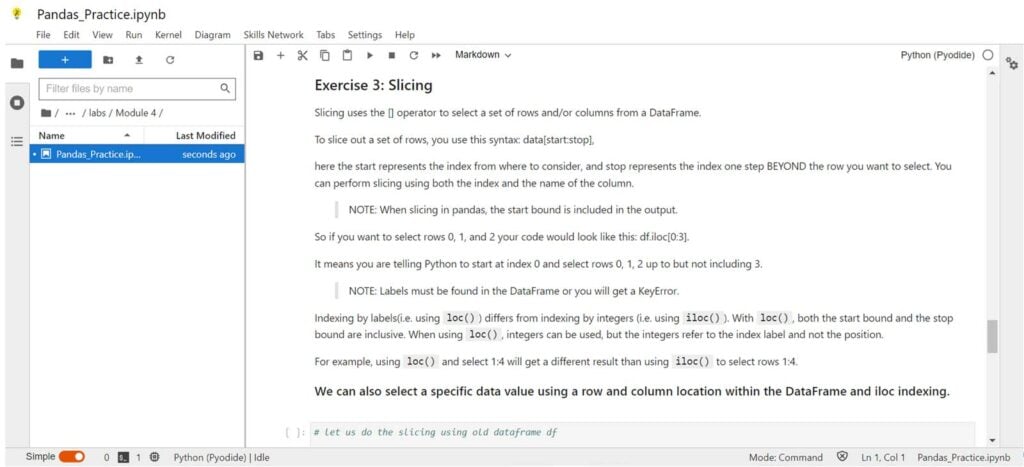
Course 5: Python Project for AI & Application Development
The Python Project for AI & Application Development, part of IBM’s Back-End Development Professional Certificate on Coursera, is a course that I found to be quite engaging. It’s a hands-on mini-course that allows you to apply your Python skills in a practical setting, specifically in the development of AI-powered applications.
The course content is structured in a way that it starts with the basics of packaging and unit testing in Python, gradually moving toward more advanced concepts. The use of Flask, a Python micro web framework, is a smart choice as it is widely used in the industry and offers a great learning experience.
What I particularly appreciated was the course’s emphasis on real-world application. The final assignment, where you are tasked with building your own Python web application, is a standout feature. It is a practical, hands-on experience that allows you to apply the knowledge you have gained throughout the course.
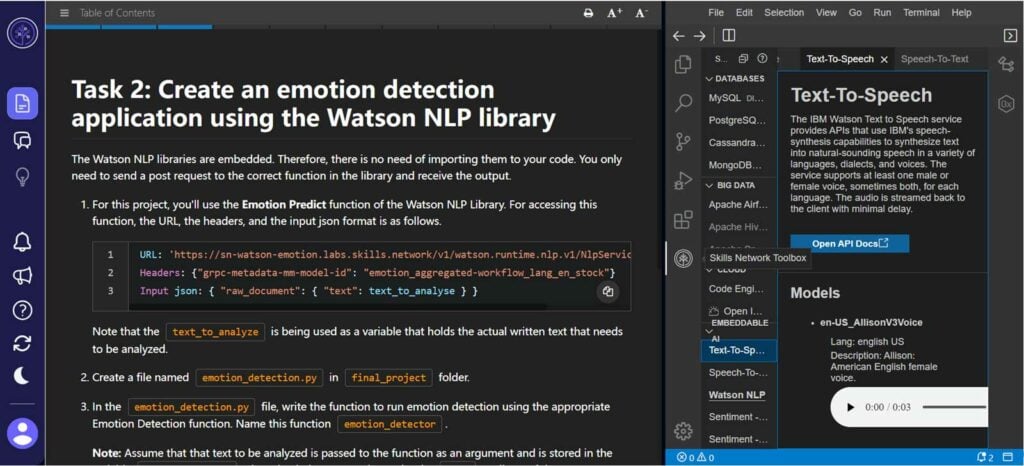
However, I must stress that this course is not for beginners. It is recommended that you have a solid foundation in Python and data handling before enrolling. If you are up for the challenge, this course can be a valuable addition to your learning journey.
In terms of fitting into the overall program, I believe it does so seamlessly. It provides a practical application of Python skills in a real-world context, which is a crucial aspect of back-end development. In conclusion, while the course is challenging and requires a certain level of prior knowledge, it offers a rewarding learning experience for those interested in AI and application development. It is a worthy component of the IBM Back-End Development Professional Certificate.
Course 6: Developing Applications with SQL, Databases, and Django
The course is a deep dive into the world of databases, SQL, and Django’s object-relational mapping (ORM). It assumes a certain level of familiarity with GitHub, Python, HTML, and CSS, which is fair considering it is part of a larger program. However, if you are a beginner in these areas, you might find the learning curve a bit steep.
The course content is comprehensive, covering everything from creating entity-relationship data models to executing common database operations using SQL. The integration of Django ORM is particularly noteworthy as it allows developers to work with databases using Python, eliminating the need to write SQL code. One aspect I appreciate is the hands-on approach. The course is peppered with practical labs and a final project that allows you to apply what you have learned. The project, a Django web app deployed on the cloud, is a great opportunity to gain real-world experience.
The course is well-structured, with each week building on the previous one. However, I felt that the course could have been a bit more balanced. There is a lot of focus on individual topics, but a more holistic view of how everything fits together in the larger scheme of back-end development would have been beneficial.
Course 7: Introduction to Containers w/ Docker, Kubernetes & OpenShift
The seventh installment of IBM’s Full Stack Software Developer Professional Certificate, “Introduction to Containers w/ Docker, Kubernetes & OpenShift,” is a course that I believe holds significant value for software engineers and developers aiming to deepen their understanding of containerization.
The course is well-structured, breaking down complex concepts into digestible modules. It provides a comprehensive overview of containerization, starting with the basics and gradually moving into more advanced topics. The use of Docker, Kubernetes, OpenShift, and Istio in the course content is a smart move, given their widespread industry adoption.
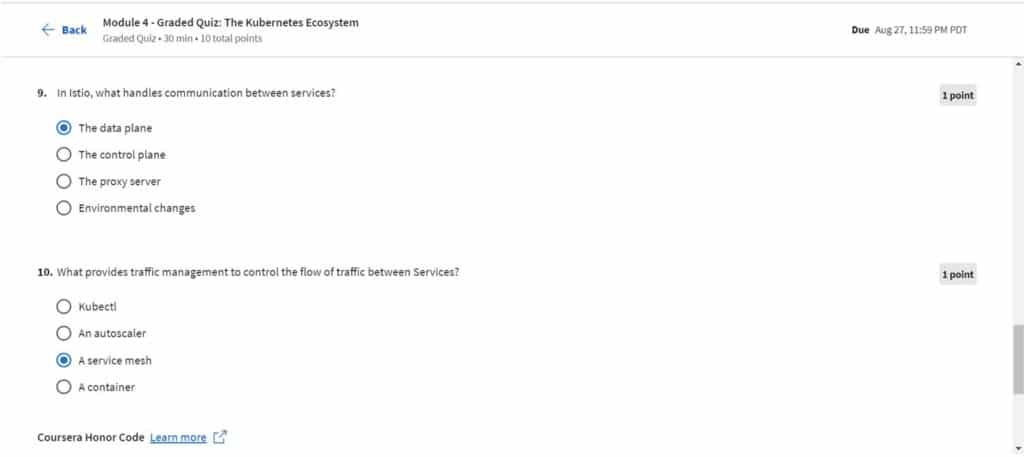
What I particularly appreciate is the hands-on approach. The browser-based labs and final assignment, which involves deploying a guestbook application using Kubernetes and Docker, provide practical experience that is crucial for truly understanding the material.
However, the course could benefit from more real-world examples and case studies to illustrate the application of these tools in various scenarios. While the course does a good job of explaining the technical aspects, it could do more to contextualize this knowledge within the broader industry landscape. In terms of fitting into the overall program, this course is a logical addition. Containerization is a key skill for modern back-end developers, and this course provides a solid foundation in this area.
Course 8: Application Development using Microservices and Serverless
This course caught my attention due to its focus on trending topics in the tech industry. It does a commendable job of introducing the concept of microservices, contrasting it with monolithic architectures. It is a great way to understand how complex applications can be broken down into smaller, manageable, and scalable components. However, I felt that the course could have been rooted deeper into the challenges of managing microservices, which would have provided a more balanced perspective.
The section on serverless computing is well-executed, offering insights into how it enables developers to focus on their applications without worrying about infrastructure management. The hands-on labs are a highlight, providing practical experience with serverless frameworks. Nevertheless, the course could help with more practical examples to illustrate the use cases of serverless technologies.
The final project is a comprehensive test of the skills acquired, requiring learners to create a front-end application composed of multiple microservices. It is a valuable opportunity to apply the concepts learned, but I felt that more guidance could have been provided to navigate this complex task.
Overall, this course offers a good introduction to microservices and serverless computing. It fits well into the overall program, providing essential skills for modern back-end development. However, it could benefit from a more balanced discussion of the challenges associated with these technologies and more real-world examples. Despite these minor shortcomings, I believe it is a worthwhile addition to any developer’s learning journey.
Course 9: Application Security and Monitoring
This course is a deep dive into the world of application security, a critical aspect of back-end development that often does not receive the attention it deserves. The course content is comprehensive, covering a wide range of topics from security by design principles to application performance monitoring. I appreciated the focus on practical skills such as defensive coding following OWASP principles, vulnerability scanning, and pen testing with Kali Linux. These are skills that are immediately applicable in the real world, making the course highly valuable for those already working in the field.
It also does a commendable job of integrating the concept of security throughout the software development lifecycle (SDLC), emphasizing the importance of a Secure Development Environment. It is not just about patching vulnerabilities; it is about developing with security in mind from the start.

The hands-on labs and peer discussions are a great addition, providing an opportunity to apply the theoretical knowledge gained and interact with fellow learners. While it could benefit from a more integrated approach and additional real-world examples, it remains a valuable resource for anyone looking to enhance their back-end development skills.
Course 10: Back-end Application Development Capstone Project
The Back-end Application Development Capstone Project, the grand finale of the IBM Backend Development Professional Certificate, is an immersive and rewarding experience. It is a hands-on course that allows you to put into practice all the skills you have honed throughout the program.
The course’s real-world application is its standout feature. You are not just absorbing theory; you are applying it. You are tasked with developing and deploying a full-fledged back-end application, a task that is as challenging as it is exciting. The use of Flask, Django, NoSQL, and MongoDB in this project underscores the course’s commitment to a comprehensive and practical learning experience.
The course’s emphasis on microservices and REST APIs is particularly commendable. This is a vital aspect of back-end development, and the course does an excellent job of weaving it into the capstone project. The inclusion of Docker, Kubernetes, OpenShift, and serverless technologies for containerization and deployment adds a layer of realism and complexity to the project, preparing you for the challenges of the real world.
While the course is hands-on, it does a good job of providing the necessary theoretical grounding. It strikes a balance between theory and practice, making it accessible to learners at different levels of expertise.
Additionally, it is a worthy culmination of the IBM Backend Development Professional Certificate. It is challenging, comprehensive, and gives you a glimpse of what real-world back-end development entails. It is a robust learning experience that will undoubtedly boost your skills and enrich your portfolio.
What do others say?
Reviews of the course on Coursera are generally positive, with many students praising the comprehensive syllabus, clear delivery, and practical exercises. However, some students have raised concerns about the time commitment required and the lack of live support.
Reviews on other platforms, such as Google, Class Central, and Reddit, are also generally positive. Many students appreciate real-world projects and the opportunity to earn a certificate from IBM.
My recommendation
The IBM Back-End Development Professional Certificate is a standout choice for anyone venturing into back-end development. Its comprehensive syllabus, industry relevance, and practical projects set it apart from other similar courses. The collaboration between IBM and Coursera ensures learners are exposed to the latest industry trends, best practices, and real-world applications. Moreover, the learning experience in the “IBM Back-End Development” Professional Certificate is well-rounded and engaging, offering a blend of theory and hands-on practice to prepare learners for real-world scenarios.
Despite requiring a significant time commitment and lacking live support, the course’s well-structured syllabus, high-quality delivery, and practical exercises make it a worthwhile investment. Whether you are a beginner or a front-end developer looking to expand your skills, this course comes highly recommended.
$100 USD off your first year of Coursera Plus Annual (expires 1 April 2024)
